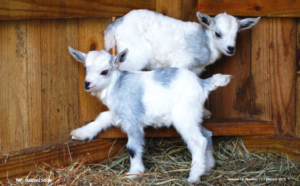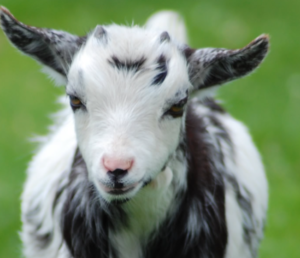Standing less than 2 feet tall, adult pygmy goats weigh 53 to 75 pounds for females; males weigh from 60 to 86 pounds and have long, bushy beards. Both sexes have horns, contrary to popular belief.
The two original breeds of pygmy goats, African pygmies and Nigerian dwarfs, originated from the Cameroon Valley of West Africa and were brought into European zoos. The goats were then imported into the United States from the 1930s to the 1950s as research animals. Eventually, some private breeders found them cute, acquired them, and bred them as exhibition animals, petting zoo regulars, and backyard pets.

Pygmy goats are herd animals, which means they need a companion, even if the companion is not of their own kind. That means they enjoy being around people and other animals, and are very sociable creatures. Ideally, however, you will need to buy a minimum of two goats to start off, as single goats get lonely and will often bleat loudly and call out for company.
If you buy them from the same herd, they will already be acquainted with each other and will help each other adjust to their new surroundings more quickly. Also, goats will sometimes bond with with hoofed animals like sheep, horses, or cows.If treated with kindness and respect, pygmy goats can be very affectionate. Pygmy goats can live for eight to twelve years on average, so a pet pygmy goat will be a companion (and a commitment) for the long term.
Just like dogs, multiply a goat’s age in years by seven to get the equivalent human age. Pygmy goats don’t bite, and they don’t mind being carried, so they make great family pets, even for families with small children. The goats should have at least an hour of interaction and attention everyday, although it doesn’t have to be all at once.
Many people keep pygmy goats in their backyards, which is ideal not only because they need adequate space to roam and run around, but also because they feed on grass and little plants. Pygmy goats, like all goats, are browsers, not grazers. Browsers nibble on the tops of grass and little plants, so they leave your lawn clipped at a certain length.
Grazers, like horses and cows, eat grass down to the roots, and will uproot your perfectly manicured lawn. This also means that goats do not compete with grazers for food, and can be raised alongside them.  Don’t tether your pygmy goats; fence them in to keep them safe and protected. Wild canines such as coyotes and dogs often prey upon unprotected goats. Make sure the goats can’t slip through gaps in the fence!
Don’t tether your pygmy goats; fence them in to keep them safe and protected. Wild canines such as coyotes and dogs often prey upon unprotected goats. Make sure the goats can’t slip through gaps in the fence!
These goats are intelligent animals and will find a way to escape if you aren’t careful. Make sure that any braces or fence posts are outside the fence. Otherwise, the goats will find a way to climb them. They will even use the roof of their shelters to escape so make sure the shelter’s roof cannot be climbed. Pygmy goats eat more than grass. They should be fed grain off the ground – meaning in a trough or bowl – so the grains don’t get spoiled.
They should also have a salt lick available to ensure that they get plenty of vitamins and minerals. Don’t forget their water! Pygmy goats get thirsty often. Make sure they have a drink available at all times. Change the water in their trough every day, and wash out and rinse the trough whenever the water is changed.
Some people milk their pygmy goats, and these critters can be made to produce milk year round. A single pygmy goat can produce up to half a gallon of milk a day. Pygmy goat milk is of a high quality, with a high milk fat content of 7-9%. This helps the milk resist the flavors that might come from the goat’s diet, which can be widely varied. It also makes the milk rich and sweet.
Like their bigger brethren, Pygmy goats will eat just about anything, especially if left unsupervised–anything from newspapers to plastic bags and poisonous plants. Keep their four-chambered stomachs out of trouble by restricting their access to edible things and feeding them green leafy vegetables, grains like oats and corn, and hay.
Alfalfa, also known as grass hay, is packed with nutrition, for pygmy goats as well as humans. Any kind of hay is an important part of any pygmy goat’s diet, as it provides the necessary roughage that can help prevent the common digestive diseases that sometimes strike pygmy goats.Pygmy goats use their hooves to climb high objects, like their full-sized cousins. Give them items to jump on like rocks, benches, tables, and stumps. Pygmy goats love to play and will make their own fun!
Although pygmy goats are adaptable to a wide variety of climates, make sure they have shelter from the elements, especially during the rainy months. A small shed or a lean-to will do, as long as it keeps them dry, because pygmy goats hate getting wet. Make sure the shelter’s opening is facing away from the wind and rain.

Also, remember to trim their hooves every two months with pruning shears or sheep hoof trimmers, and brush their coats regularly. Fortunately, pygmy goats love getting their coats brushed and will often come willingly for a grooming session.Unfortunately it seems like goats aren’t really aware of when they defecate, so you probably won’t be able to house train them.
Be prepared, especially if you intend to keep the goat indoors, and plan accordingly for cleanup. Like any farm pet, pygmy goats need to get shots. They require annual Tetanus C and D shots that protect them from tetanus as well as enterotoxoma or overeating disease. If your area is selenium-deficient, selenium supplements are a helpful addition to any pygmy goat’s diet. Also, goats are prone to worms, and goats with worms will have a rough coat, a ratty appearance, and weight loss, despite a healthy appetite. Regular vet visits will help prevent many diseases.
This appeared in Animal Scene’s January 2016 issue.






